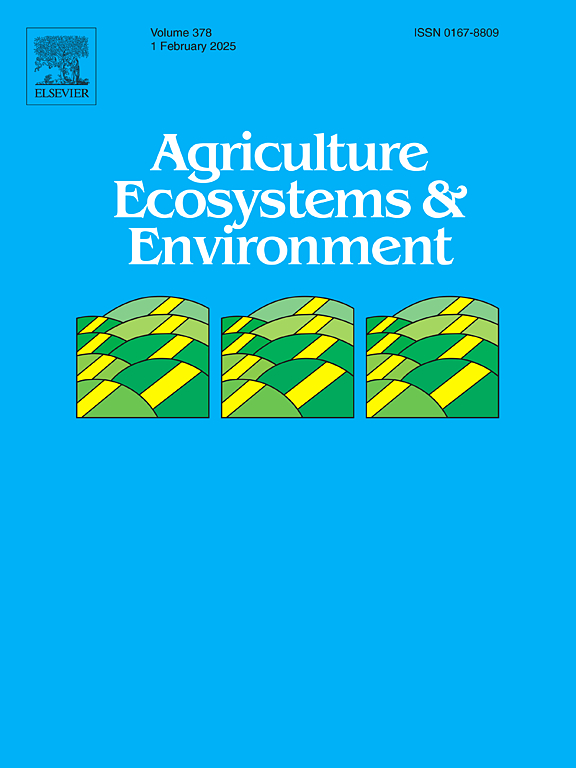Ecological impact of conventional, organic and biodynamic viticultural systems and associated practices on soil microbiota in different French territories
IF 6.4
1区 农林科学
Q1 AGRICULTURE, MULTIDISCIPLINARY
引用次数: 0
Abstract
Organic (OV) and biodynamic (BD) production systems have developed substantially as alternatives to conventional systems (CV) to increase the sustainability of viticulture. However, their impact on the biological quality of soil is still poorly documented. Here, we characterised different soil microbiota parameters in a network of 152 vineyard plots using molecular tools based on soil DNA characterisation. The plots were equally distributed in three French viticultural territories (Alsace, northern Burgundy, southern Burgundy) and selected to balance the relative share of each production system (1/3 of CV, OV and BD). Data on soil management practices such as soil tillage, inter-row plant cover and fertilisation were also collected for each plot to explore their impact on the soil microbiota. More intensive soil tillage, sparse inter-row plant cover, and the export of vine shoots frequently observed in northern Burgundy plots partly explained the reduction of ∼50 % of molecular microbial biomass, ∼15 % of microbial diversity and ∼90 % of microbial interactions compared to the soils sampled in Alsace. Variance partitioning of the cumulated microbial dataset showed higher microbial biomass and bacterial richness in OV than in CV and in BD than in OV. The complexity of microbial interactions networks increased by about 145 % in BD compared to CV and decreased by about 37 % in OV compared to CV. Our findings suggest that while OV and BD systems can enhance soil microbiota quality, their benefits could be further optimized through improved cover cropping and reduced tillage.
法国不同地区传统、有机和生物动力葡萄栽培系统及相关做法对土壤微生物群的生态影响
有机(OV)和生物动力(BD)生产系统作为传统系统(CV)的替代品已经得到了长足的发展,以提高葡萄栽培的可持续性。然而,它们对土壤生物质量的影响仍鲜有文献记载。在这里,我们使用基于土壤DNA特征的分子工具,对152个葡萄园地块的不同土壤微生物群参数进行了表征。这些地块平均分布在三个法国葡萄产区(阿尔萨斯、北勃艮第和南勃艮第),并选择平衡每个生产系统的相对份额(1/3的CV、OV和BD)。每个地块还收集了土壤耕作、行间植被覆盖和施肥等土壤管理措施的数据,以探讨其对土壤微生物群的影响。与阿尔萨斯取样的土壤相比,勃艮第北部地块的土壤耕作强度更高,行间植物覆盖稀疏,葡萄枝出口频繁,这在一定程度上解释了为什么分子微生物生物量减少了~ 50% %,微生物多样性减少了~ 15% %,微生物相互作用减少了~ 90% %。对累积的微生物数据集进行方差划分,结果显示OV的微生物生物量和细菌丰富度高于CV, BD的微生物生物量和细菌丰富度高于OV。与CV相比,BD中微生物相互作用网络的复杂性增加了约145 %,OV中微生物相互作用网络的复杂性减少了约37 %。我们的研究结果表明,虽然OV和BD系统可以提高土壤微生物群质量,但可以通过改善覆盖种植和减少耕作来进一步优化它们的效益。
本文章由计算机程序翻译,如有差异,请以英文原文为准。
求助全文
约1分钟内获得全文
求助全文
来源期刊

Agriculture, Ecosystems & Environment
环境科学-环境科学
CiteScore
11.70
自引率
9.10%
发文量
392
审稿时长
26 days
期刊介绍:
Agriculture, Ecosystems and Environment publishes scientific articles dealing with the interface between agroecosystems and the natural environment, specifically how agriculture influences the environment and how changes in that environment impact agroecosystems. Preference is given to papers from experimental and observational research at the field, system or landscape level, from studies that enhance our understanding of processes using data-based biophysical modelling, and papers that bridge scientific disciplines and integrate knowledge. All papers should be placed in an international or wide comparative context.
 求助内容:
求助内容: 应助结果提醒方式:
应助结果提醒方式:


